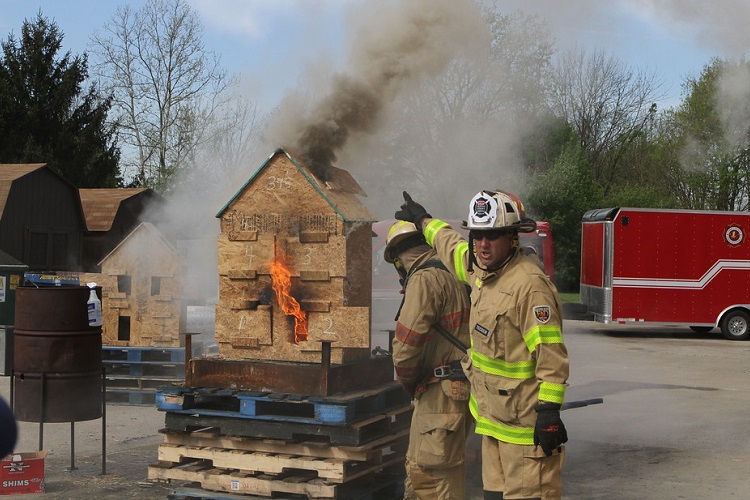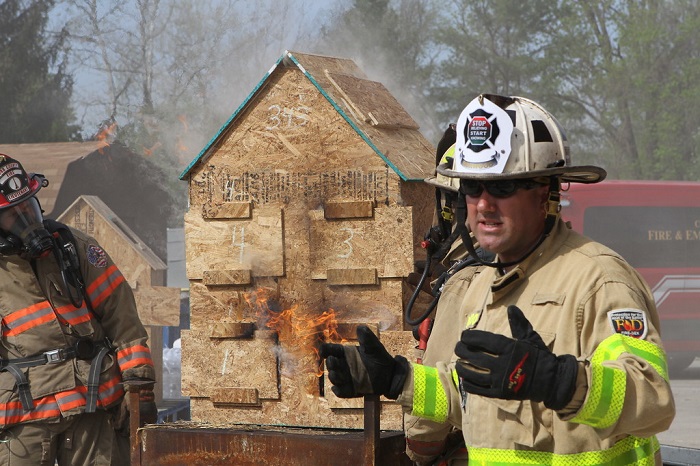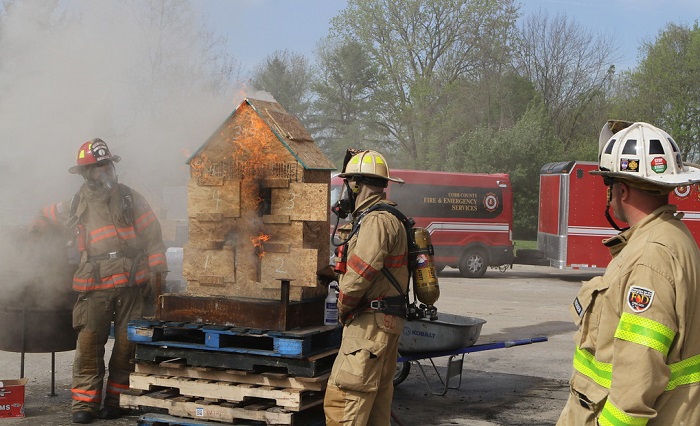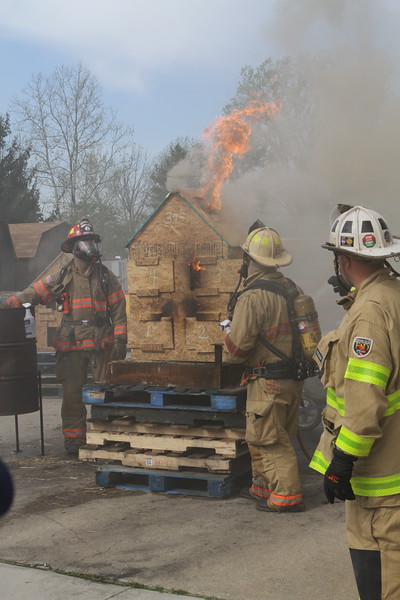

By P.J. Norwood and Sean Gray
Every time the tones strike, there will be some uncertainty of what we will face. Today, we are faced with a broader range of hazards then at any other time in the history of the fire service. Firefighters across the country continue to be tasked with new, emerging challenges each day. Not surprisingly, every task is accomplished with the utmost professionalism. Regardless of how firefighters meet those challenges and rise to the top, they must deal with the needs of every incident.
The police department continues to be challenged as well. The one big difference between the law enforcement arm of public safety and the fire service is that the police’s job is extremely unpredictable. We like to give the police a hard time about how they simply took the wrong test. However, we couldn’t be police officers because everything they do is completely unpredictable. They deal with the human factor, and there is nothing they can do to predict an outcome. Although our job is somewhat unpredictable, there are many aspects that are predictable if you are prepared. As a fire service professional, you must never take what you think you know for granted. You must continually study and learn as much as you can about every aspect of your profession. The more you learn and the more you prepare, the more that will be predictable.

One of the biggest areas for firefighter improvement is education and knowledge that focuses on fire behavior and fire dynamics. For many of us, we entered the fire service after sitting through a lesson on fire behavior that included a four-hour block that was lecture-based. It surrounded the fire tetrahedron and went through some terms and definitions. The instructor stomped his foot a few times to highlight the necessity that we use our highlighters as we “may see that again.” Then we moved on. We began to focus of fire extinguishment, search, ventilation, forcible entry, and so on. Although every one of those tactics has a direct impact on fire behavior, we never again discussed it. When we focus on the individual tactics, everyone impacts the fire behavior positively, and we discuss that. But have you ever had a meaningful conversation on the negative impact on fire behavior based on those tactics?
We need to increase our understanding and the difference between fire dynamics and fire behavior. Fire dynamics is the study of how a fire starts, spreads, and develops. Fire dynamics has the scientific measurements and calculations needed to explain fire behavior. Fire behavior is exactly what it sounds like it would be; it is the way that fire reacts and behaves to its environments.
Modern fire development commonly relates to ventilation-limited fires. Early on, there is enough air to mix with gases and create complete flaming combustion of those gases. Some would consider this as “flashover,” but as the fire starts to run out of air, it starts to decay, and temperatures decrease. When firefighters arrive on scene and open a door to gain access to the structure, and a door or window fails or a bystander opens a door to try to evacuate residents, air rushes in to give the fire the air it needs to grow rapidly and likely flash over into a fully developed compartment fire.

Flashover is a dangerous transition between the growth stage and fully developed stage. It is unpredictable and will cause serious injury or even kill firefighters if the precursors go unrecognized on the fireground. When fire gases ignite completely and the radiant heat from the initial growth stage of the fire ignites the room’s contents, rapid-fire growth spreads within the compartment. Depending on the compartment size and the amount of pressure that builds up prior to flashover, there could be a pressure wave seen with the flashover, causing witnesses to describe something like a backdraft. Although this phenomenon has become more common, it’s likely been around many years and described as a “backdraft” in the past.
RELATED: Ledin on Water Behavior ‖ Reeder: Fire Behavior and Building Construction Drills ‖ Havel: Fuels and Fire Behavior
However, the dated definition of “backdraft” from our basic firefighter certification textbooks describes it as an event that occurrs at temperatures greater than 1,600°F, smoke stained windows, yellow-gray smoke, and so on. When modern fires become ventilation limited, the temperatures decrease significantly. However, by the older definition, the temperatures are greater than 1,600°F, causing there to be conflict in the definition of the ventilation limited blasts that we are seeing in today’s fires. There is an updated definition for backdraft in National Fire Protection Association 921, Guide for Fire and Explosion Investigations (2011 version):
Backdraft: “A deflagration resulting from the sudden introduction of air into a confined space containing oxygen-deficient products of incomplete combustion. This can occur in attic spaces, knee walls, or any other void space found on many documented fires that have injured firefighters across the country. On these incidents, the fire remains hidden and ventilation limited until a firefighter creates a hole to find the fire and gives it just enough air to rapidly ignite, catching the firefighter off-guard and possibly causing injuries. It could be something as simple as poking a small hole in the ceiling to check for fire or smoke spread above the firefighter’s head as previously taught in many strategy and tactics books.”
“For every action, there is an equal and opposite reaction.”
–Sir Isaac Newton’s third law of motion

In the above scenario, it is common to see a time delay from the initial opening created by firefighters until the flashover occurs. Although this time delay varies, it needs to be recognized by firefighters. The old saying “Where there is smoke, there is fire” applies to these situations. If a small opening is made, apply water to the smoke and into the compartment as quickly as possible to reduce the temperatures and stop the occurrence of a fire growth. Again, firefighters must be aware of the consequences when creating openings within a structure fire.
Controlling the ventilation openings is critical on the fireground because we need to avoid creating a flow path until it is necessary for rescue or extinguishment. When this occurs, recognize and then control the flow path, if possible. Recognizing fire behavior as it changes and reacts to our tactics is possibly one of the most underused skills for firefighters. Not only should we recognize the fire behavior that occurs from ventilation openings we make but we should also recognize window or door failures caused by fire conditions. These window and door failures have caused firefighter injuries and deaths. These openings are unpredictable, but a solid size-up should recognize imminent failure to a window or door.

Interrupting the flow path involves tactics that are innovative and sometimes counterintuitive, but fire research shows that these methods can reduce heat within the structure, minimize the potential for flashover, and greatly enhance firefighter safety. Although this can vary depending on location and size of the fire, the time between tactical ventilation and flashover in a structure could be two minutes, compared to eight minutes in a traditional fire, giving firefighters only 25 percent of the time they previously had to recover from poorly timed ventilation. We need to formulate safe and effective ventilation tactics so we can better understand flow paths. The flow path is the space through which fire, heat, and smoke progress, moving from an inlet and the high-pressure fire area to where the fire moves toward lower-pressure oxygen sources (e.g., outlet areas such as door and window openings). Based on varying building configurations, there may be several flow paths within a structure. Firefighting or rescue operations conducted in a flow path can place firefighters at significant risk.
Fire behavior has not changed; the principles are still the same. However, many of the materials and fuel packages in today’s fires have changed. Some will debate that there were plastics in homes 30 years ago. That is accurate, however, the amount of plastic and polystyrene are now more abundant in every home, which should directly affect into our training.
Today’s training sets up firefighters for failure, so we must begin identifying what we can do during our training to truly prepare ourselves and officers for their next fire. Generally, our live fire training is unrealistic. We fight fires in concrete buildings with a limited fuel load of pallets and hay. We tell firefighters to stretch into the room, flow a little bit of water (“don’t put the fire out”), and back out. We also have them vent by opening the windows and doors. When this task is done, everything gets better. On the fireground, flowing a little bit of water and opening the structure up does not always equal positive results.
Educating today’s firefighters and officers and reinforcing fire behavior and fire dynamics lessons are imperative. The downside is the limited ability to grab and keep their attention in classroom training when you begin that lecture with the title of “Fire Behavior.” Reinforce classroom lectures through small-scale fire behavior lessons. Most firefighters are visual learners; they are less inclined to sit in a classroom reading words on a slide presentation.
Using a four-compartment “Palmer’s Box” (also referred to as a “dollhouse”) can easily demonstrate and show firefighters the effects of fireground ventilation both positively and negatively and help them practice reading smoke and predicting backdrafts and flashovers. You can discuss choosing the proper tactics, size-up, task-specific size-up (such as vent-enter-isolate-search) as well as demonstrate improper nozzle selection effects on the amount of air entrained into a structure and the impact it has on the fire. You can clearly demonstrate smoke is fuel and an important lesson of ventilation point ignition.
The time has come to begin realistic training that truly prepares us. Download the plans to build a Palmer’s House below and the associated lesson plan. Build two boxes today, and you will open up a whole new dialogue within your department.
View the Fire Engineering Training Minutes video of the dollhouse burn at http://emberly.fireengineering.com/articles/2016/07/firefighter-training-video-fire-behavior.html.
Download the plans to build the Palmer’s Box at www.stopbelievingstartknowing.com.

SEAN GRAY entered the fire service in 1993 and is a lieutenant with Cobb County (GA) Fire and Emergency Services in Metro Atlanta. He is an appointed member to the UL Fire Safety Research Institute advisory board; was a Technical Panel member for its Study of Residential Attic Fire Mitigation Tactics & Exterior Fire Spread Hazards; and is a member of its Technical Panel for the Study of the Fire Service Training Environment: Safety, Fidelity, and Exposure. He participated in the Illinois Fire Service Institute Cardiovascular & Chemical Risks of Modern Firefighting research study. He has a bachelor’s degree in fire safety engineering from the University of Cincinnati. He has been published in Fire Engineering, is an FDIC H.O.T. lead instructor, and delivers lectures on evidence-based tactics across the United States.
P.J. NORWOOD is a deputy chief training officer for the East Haven (CT) Fire Department and has served four years with the Connecticut Army National Guard. He is an FDIC classroom, workshop, and H.O.T. instructor; a Fire Engineering educational advisory board member, and a Fire Engineering book and video author. He was a member of the UL Technical Panel for the Study of Residential Attic Fire Mitigation Tactics and Exterior Fire Spread Hazards on Fire Fighter Safety. He has lectured across the United States and overseas. Norwood is certified to the instructor II, officer III, fire marshal, and paramedic levels.

